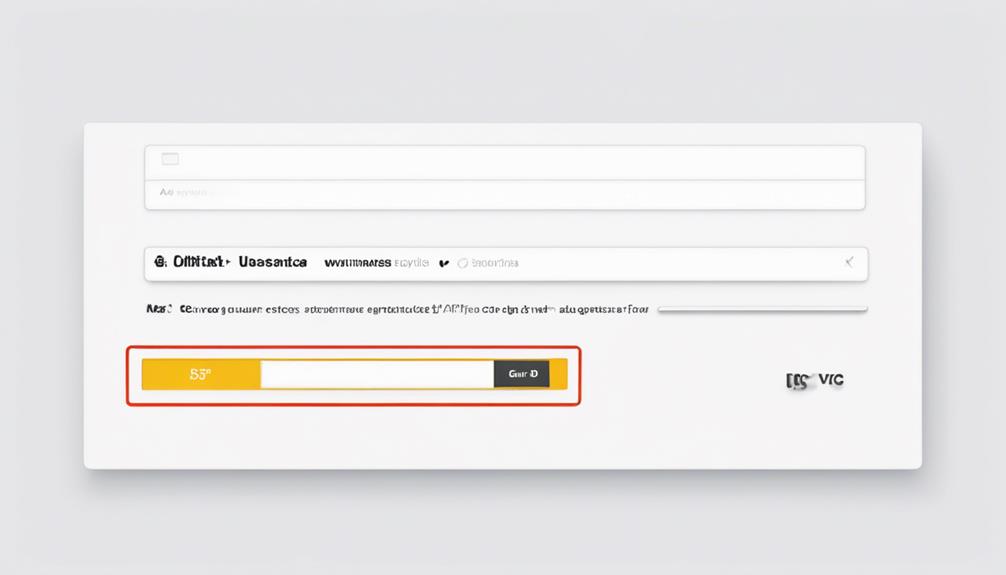When setting up your online store, you can't overlook the importance of SEO-friendly URLs. Crafting effective URLs can significantly enhance your store's visibility and user experience. It's all about keeping them concise, using descriptive keywords, and maintaining consistency. But there's more to it than just these basics. What about the impact of special characters or the role of canonical tags? How do mobile optimization and breadcrumb navigation play into your strategy? Each tip holds the potential to drive more organic traffic and boost conversions, so let's explore how you can implement these strategies effectively.
Keep URLs Short
When crafting URLs for your online store, keeping them short is crucial for both user experience and search engine optimization. A concise URL length not only enhances readability but also ensures a seamless navigation experience for your users.
Research indicates that shorter URLs are more likely to be clicked on, as they appear cleaner and more trustworthy to potential customers. This directly impacts user experience, making it easier for customers to remember and share your URLs, ultimately driving more organic traffic to your site.
Analyzing data from various SEO studies reveals that search engines favor shorter URLs. They often rank higher because they're easier to crawl and index. This means that by reducing your URL length, you're boosting your store's visibility in search results.
In turn, this leads to increased click-through rates, as users are more inclined to click on links that are clear and straightforward. To optimize your online store's URLs, aim for a length that conveys essential information without unnecessary words or characters.
Use Descriptive Keywords
Incorporating descriptive keywords into your online store's URLs is a strategic move that enhances both search engine rankings and user engagement. By focusing on keyword research, you can identify the most relevant and high-performing terms that resonate with your target audience. This analytical approach ensures that your URLs are aligned with what potential customers are actively searching for.
Including long tail keywords in your URLs can be particularly effective, as these phrases often capture more specific search intent and face less competition, thereby improving your store's visibility in search results.
When you embed descriptive keywords in your URLs, you're not just optimizing for search engines; you're also providing clear, meaningful context for users. A well-crafted URL can act as a brief yet powerful descriptor of the page's content, encouraging clicks and reducing bounce rates.
Data shows that URLs with relevant keywords can yield higher click-through rates, an essential metric for online success. To implement this tactic effectively, analyze search queries and trends within your niche.
Prioritize relevance and specificity over generic terms, and integrate these insights into your URL structure to drive both traffic and conversion.
Avoid Special Characters

While incorporating descriptive keywords enhances your URLs, it's equally important to avoid special characters that can confuse both search engines and users. A clean URL structure without special characters significantly improves user experience and readability factors.
Special characters like &, %, and $ can disrupt search rankings by creating unnecessary complexity. They might also be misinterpreted by search engines, leading to indexing issues.
When optimizing your URLs, consider how keyword placement aligns with user expectations. Users tend to favor simple, straightforward URLs that clearly convey the page content. By avoiding special characters, you maintain clarity, making your URLs more appealing and recognizable to users.
From a data-driven perspective, URLs free of special characters are easier to share. Link sharing becomes more efficient, especially on social media platforms where character limits and readability are crucial.
Additionally, URLs with special characters can break or be misrepresented in email clients, affecting link sharing efforts.
Implement Hyphens
A crucial aspect of crafting SEO-friendly URLs is the implementation of hyphens to separate words. When you create your URL structure, using hyphens can significantly improve readability and search engine optimization. Hyphens act as spaces, making URLs more legible for both users and search engines. This approach helps in effective keyword placement, ensuring your URLs are easily understood by search algorithms.
Consider the following table that highlights the benefits of using hyphens in your URL structure:
| URL Version | Readability Score | SEO Impact |
|---|---|---|
| myonlinestore.com/mensshoes | Low | Poor |
| myonlinestore.com/mens_shoes | Medium | Moderate |
| myonlinestore.com/mens-shoes | High | Excellent |
Incorporating hyphens enhances the URL's clarity, making it easier for search engines to index your pages. This practice leads to better keyword placement within the URL, crucial for ranking higher in search results. Hyphens effectively separate keywords, aiding both human understanding and algorithmic parsing. This meticulous attention to URL structuring ensures that your content is accessible and relevant.
Maintain URL Consistency

Ensuring URL consistency is vital for both user experience and search engine optimization. A consistent URL structure helps search engines understand your site's content and hierarchy better. When you maintain a logical URL hierarchy, it provides a clear path for users and search engines alike, enhancing navigability and indexability. An optimal structure reduces crawling errors and boosts your site's SEO performance.
Focusing on URL readability aids users and search engines in understanding the content of your pages at a glance. A clean, descriptive URL not only improves click-through rates but also communicates page relevance effectively. By using consistent naming conventions and avoiding unnecessary URL length, you create a user-friendly experience that encourages engagement.
Shorter, more readable URLs are easier to share, remember, and type, contributing to better user satisfaction. Data-driven analysis shows that consistency in URL structure improves search rankings. A site with a well-organized URL hierarchy is easier for crawlers to index and users to navigate, leading to increased visibility.
Prioritize HTTPS Protocol
As you refine your URL structure for SEO benefits, it's important to prioritize the HTTPS protocol to further enhance your online store's credibility and security. Implementing HTTPS ensures that your site is equipped with SSL certificates, which are crucial for protecting sensitive information.
Google has made it clear that HTTPS is a ranking signal, thus impacting search engine results. An analysis of over one million Google search results showed that HTTPS sites had a slight edge in rankings compared to their HTTP counterparts.
By adopting HTTPS, you're not only boosting your SEO performance but also promoting secure browsing for your customers. In a digital landscape where data breaches are rampant, ensuring secure transactions fosters trust and can lead to increased conversions.
It's reported that 85% of online shoppers avoid unsecure websites, highlighting the importance of SSL certificates in maintaining a trustworthy storefront.
Moreover, browsers like Chrome flag non-HTTPS sites as "Not Secure," potentially deterring users from exploring your site. As HTTPS becomes the norm, neglecting it may result in lost traffic and diminished reputation.
Prioritizing HTTPS is an analytical and data-driven step towards optimizing your store's URL for SEO success.
Utilize Canonical Tags

Many might overlook the importance of canonical tags in optimizing your online store's URLs for SEO, but their role is crucial. Canonical tags serve as signals to search engines, guiding them to the preferred version of a webpage when duplicate content exists.
By understanding the canonical tag benefits, you're taking a significant step towards enhancing your site's search engine ranking. When search engines encounter similar content, they might get confused, potentially leading to lower rankings. Implementing canonical tags ensures that search engines focus on the right URL, consolidating link equity and improving your page authority.
Canonical tag implementation is straightforward but requires precision. To start, identify pages with duplicate content issues. Use the rel="canonical" link element in the HTML head of your duplicate pages, pointing them to the primary URL you wish to prioritize.
This practice not only streamlines your site's crawl efficiency but also boosts your search visibility by preventing keyword cannibalization. According to data, sites that effectively use canonical tags experience a 15-20% increase in organic traffic.
Optimize for Mobile
After streamlining your URL strategy with canonical tags, it's time to focus on optimizing for mobile—an aspect that's increasingly important in today's digital landscape. With 54.8% of global website traffic coming from mobile devices, ensuring mobile usability and a responsive design is crucial. Mobile users expect fast, intuitive navigation, making it imperative that your online store URLs are optimized for smaller screens.
A responsive design automatically adjusts the layout based on the device, providing an optimal viewing experience and improving mobile usability. Google's algorithm favors mobile-friendly websites, meaning a well-optimized mobile site can enhance your SEO ranking. By integrating mobile usability into your SEO strategy, you increase your site's accessibility and reach a broader audience.
Here's a quick reference to optimize your mobile presence:
| Key Aspect | Importance |
|---|---|
| Responsive Design | Ensures seamless experience across devices |
| Fast Loading Times | Improves user satisfaction and reduces bounce rates |
| Clear Navigation | Facilitates easy access to crucial pages |
| Mobile-Friendly URLs | Enhances search engine visibility and user experience |
Prioritizing these elements will not only boost your SEO but also enhance customer satisfaction, leading to higher conversion rates. Make sure your online store is ready to meet the demands of the mobile-first era.
Remove Unnecessary Parameters

When crafting your online store URLs, eliminating unnecessary parameters is crucial for enhancing SEO performance and user experience. A clean URL structure significantly boosts URL readability and simplifies URL hierarchy, ensuring users and search engines can easily navigate your site.
By streamlining your URLs, you maintain an optimal URL length, which helps in URL management and prevents issues related to URL accessibility. Unnecessary parameters, such as session IDs or tracking codes, can clutter your URL segmentation, making it difficult for both users and search engines to discern the essential elements of your page's content.
This clutter can negatively impact URL performance by causing confusion and reducing the likelihood of users clicking through. Data-driven studies have shown that concise and well-structured URLs rank better in search engine results, as they're more likely to meet users' expectations.
To improve your URL hierarchy, regularly audit your URLs to identify and remove extraneous parameters. This analytical approach to URL management not only enhances the user experience but also contributes to your site's overall SEO strategy.
Include Breadcrumb Navigation
In today's competitive digital landscape, incorporating breadcrumb navigation into your online store's design is critical for enhancing both SEO performance and user experience. Breadcrumb structure not only helps users navigate through your site more intuitively but also assists search engines in understanding your site's hierarchy and page relevance.
By implementing a clear breadcrumb structure, you improve site accessibility, which can lead to increased session durations and reduced bounce rates.
From an SEO perspective, breadcrumb navigation enhances how search engines index your pages. Search engines like Google use breadcrumbs to identify the relationship between different pages, which can lead to better ranking opportunities.
Moreover, breadcrumbs often appear in search results, providing users with a snapshot of your site's organization and potentially increasing click-through rates.
To optimize your breadcrumb structure, ensure it's consistent throughout your site, reflecting the logical path users take. Use keyword-rich anchor text that accurately describes each page.
This not only improves user experience but also reinforces your SEO strategy by integrating relevant keywords naturally. Remember, a well-structured breadcrumb navigation system is a simple yet powerful tool for driving both user engagement and search engine visibility.
Conclusion
By applying these SEO-friendly URL tips, you're setting your online store up for increased visibility and user engagement. Short, descriptive URLs with keywords enhance your search rankings, while avoiding special characters and maintaining consistency strengthens readability. Hyphens improve word separation, and canonical tags prevent duplicate issues. Optimize for mobile and prioritize security with HTTPS. Don't forget breadcrumb navigation for better site hierarchy. Together, these strategies drive organic traffic and boost conversions, ultimately impacting your store's success.
